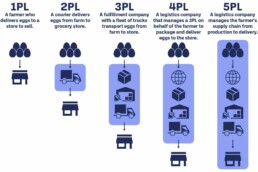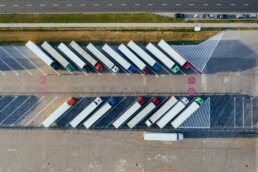The Differences Between Logistic Types: 1PL, 2PL, 3PL, 4PL, and 5PL.
Logistics management is an important component of any successful business. So you must choose the best logistics provider for your business to ensure your goods and services are delivered on time and at the right cost. Most people know about 3PL (third-party logistics), but there are several types of logistics providers. Understanding the differences between the different logistic types; 1PL. 2PL, 3PL, 4PL, and 5PL, can help you make the right choice for your business.
1PL, 2PL, 3PL, 4PL, and 5PL Defined

1PL
First-Party Logistics, or 1PL, is the most basic logistics provider. In this relationship, consisting of a supplier and retailer/customer, businesses use their resources to manage logistics and distribution. This may include hiring in-house staff, purchasing transportation, and leasing warehouses. Consequently, the shipping and receiving occur between the two parties involved, with no other middlemen involved in the process.
2PL
2PL stands for Second-Party Logistics and is an outsourced provider. In essence, Second-Party Logistics Providers focus solely on the transportation sector of business. For instance, examples of 2PLs include airlines, shipping lines, and hauling companies that operate vehicles. Notably, retailers that manage fulfillment in-house will often use a 2PL to deliver products to their final destination. As such, two prominent examples of 2PL providers are UPS and FedEx.
3PL
3PL stands for Third-Party Logistics and is a full-service provider. This logistics provider will handle all aspects of the supply chain, from warehousing to last-mile delivery. Services that a 3PL offers include; receiving, storing, packing, and shipping services. Some 3PLs, like Falcon Fulfillment, offer value-added services like inventory management, kitting and light assembly, and returns management.
According to Armstrong and Associates, 90% of Fortune 500 companies use a 3PL.
4PL
4PL stands for Fourth-Party Logistics and is a strategic partner that helps a business optimize its supply chain. This provider will help a company streamline its processes, reduce costs, and increase efficiency. 4PL providers are integrated into managing multiple aspects of the supply chain. Typically, 4PLs work like consultants who leverage relationships across 1PL, 2PL, and 3PL providers. They rely heavily on technology to optimize the logistics process, allowing them to offer a higher-level analysis of data and reporting. 4PLs provide everything a 3PL does but include project management, logistics negotiations, and strategy.
5PL
Finally, 5PL stands for Fifth-Party Logistics and is a logistics provider that works with multiple 3PLs to manage the entire supply chain. A Fifth-Party Logistics Provider is a consultant one step above a 4PL. 5PLs act as aggregators for 3PLs by bundling the needs of multiple 3PL businesses to get better service rates.
Differences Between Logistic Types: 1PL, 2PL, 3PL, 4PL, and 5PL Pros and Cons

1PL
If you are a small business with limited resources, then 1PL may be your best option. It is a simple system that makes it easy to manage. You have complete control over the logistics process. However, this system becomes limiting as you grow and can throttle business success.
2PL
Leveraging a shipping provider like FedEx, UPS, or USPS can provide a great network to ensure orders are received in a timely fashion. Using a 2PL provider is best for startups and organizations that can easily manage their fulfillment needs with in-house teams. However, one of the downsides to 2PL logistics is that it takes a very high quantity of shipments to earn volume discounts (a common benefit of 3PL partnership). Furthermore, 2PL relationships fail once orders overwhelm the existing team and warehousing space. If you spend more than 20% of your time fulfilling orders, it is probably a good time to outsource your logistics to a 3PL.
3PL
Using a 3PL provider is the sweet spot for many businesses because it allows companies to scale their sales, storage, and shipping efficiencies without adding tremendous overhead costs. When a company outgrows in-house fulfillment the logical next step is to partner with a 3PL. Conversely, if you have been partnering with a single 3PL and plan to launch internationally or would like to explore utilizing multiple 3PL relationships it is time to explore 4PL relationships.
4PL
Working with a 4PL has expansion possibilities beyond that of a single 3PL provider and can replace a logistics manager in-house. In fact, depending on your specific needs and order volume, this will determine if this additional layer of strategy is necessary to scale your business. However, with the additional expertise and data-driven insight comes additional costs as well.
5PL
Finally, working with a 5PL is typically reserved for large multinational retailers who have the order volume and capital to invest in logistics expansion. For most businesses the services provided by a 5PL are simply too expensive for their needs.
Beginner’s Guide to Third-Party Logistics (3PL)
The world of e-commerce is always changing, understanding the roll of Third-Party Logistics is integral to keeping up. This beginner’s guide to third-party logistics (3PL) will delve into the essential aspects, offering insights into fulfillment services, warehousing, and much more.
Read More…
It is important to research each type of provider to ensure you are getting a quality service that meets your specific needs. To the end, no matter which type of logistics provider you choose, it is essential to have a good understanding of your business’s requirements and goals and how they are met by what the provider offers. Ultimately, exploring the differences between 1PL, 2PL, 3PL, 4PL, and 5PL providers will help you select the right logistics provider to help your business succeed.
If you would like to learn more about how Falcon Fulfillment can help with your logistics needs, get in touch today.
Let’s Talk!
Related posts:
No related posts.

